![]()
![]()
![]()
Use LEFT and RIGHT arrow keys to navigate between flashcards;
Use UP and DOWN arrow keys to flip the card;
H to show hint;
A reads text to speech;
165 Cards in this Set
- Front
- Back
|
categories of memory
|
long term memory and short term memory (sensory memory/ short-term memory/ working memory)
|
|
|
categories of long term memory
|
declarative memory (explicit) and nondeclarative memory (implicit)
|
|
|
categories of declarative memory (explicit memory)
|
events (episodic memory) and facts (semantic memory)
|
|
|
description of episodic memory
|
specific personal experiences from a particular time and place
|
|
|
semantic memory
|
world knowledge, object knowledge, language knowledge, and conceptual priming
|
|
|
categories of nondeclarative memory (implicit memory)
|
1) procedural memory
2) perceptual representation system 3) classical conditioning 4) nonassociative learning |
|
|
procedural memory
|
skills (motor and cognitive)
|
|
|
perceptual representation system
|
perceptual priming
|
|
|
classical conditioning
|
conditional responses between two stimuli
|
|
|
nonassociative learning
|
habituation, sensitization
|
|
|
what is memory?
|
The neurocognitive capacity to encode, store and retrieve information
|
|
|
What is the fundamental task of a memory system?
|
preserve information over time
|
|
|
What is memory for?
|
1) increase our ability to function in the present and future based on our past experiences
2) support the development of an internal model of the world that improves prediction |
|
|
What does a system have to do to support these functions?
|
1) Encode, store and retrieve info
2) allow stored info to be accessed flexibly to adapt to a changing environment |
|
|
What is sensory memory?
|
"echos" in perceptual system and lasts for milliseconds
|
|
|
What are the three characteristics of short-term/ working memory?
|
1) information you are currently holding in mind
2) very limited capacity 3) lasts while you actively maintain it, or as long as nothing else comes in to bump it out |
|
|
What are some characteristics of long term memory?
|
There are many types: lasts for minutes, hours, days, years, lifetime and it has a very high capacity
|
|
|
What is amnesia?
|
An abnormal mental state in which memory and learning are effected out of all proportion to other cognitive functions in an otherwise alert and responsive patient
|
|
|
Where did Patient H.M. have damage?
|
Medial temporal lobe damage
|
|
|
What is temporal gradient in amnesia?
|
A gradient in memory loss in which recent memories are affected to a greater degree than more remote memories
|
|
|
What does ribot's law state?
|
first-in-last-out
there is a time gradient in retrograde amnesia, so that recent memories are more likely to be lost than the more remote memories |
|
|
What is Retrograde amnesia (RA)?
|
A loss of memory-access to events that occurred, or information that was learned, before an injury or the onset of a disease.
RA is often temporally graded, consistent with Ribot's Law: subjects are more likely to lose recent memories that are closer to the traumatic incident than more remote memories. |
|
|
What is anterograde amnesia?
|
a loss of the ability to create new memories after the event that caused the amnesia, leading to a partial or complete inability to recall the recent past, while long-term memories from before the event remain intact
|
|
|
What were Patient H.M's symptoms?
|
No new long term memories
Working memory intact intact implicit memory (motor learning and priming) severe memory impairment- amnesia |
|
|
H.M. had spared short-term memory and
implicit memory in spite of amnesia. What does this tell us about memory systems? |
It shows that long-term memory and short term memory are separate memory systems.
|
|
|
What part of the brain was damaged in Patient E.E.?
|
inferior parietal and superior temporal damage
|
|
|
What were Patient E.E.'s symptoms?
|
lost short term memory
intact long term memory |
|
|
What type of dissociation can be studied with patient H.M. and EE?
|
double dissociation because if one manipulation affects the first variable and not the second, the other manipulation affects the second variable and not the first
|
|
|
What are 5 characteristics of working memory?
|
keeps active a limited amount of info
brief time span rapidly accessible frequently updated used for higher cognitive processes |
|
|
What are some components of working memory?
|
encoding, storage and retrieval of information
|
|
|
What are executive processes?
|
Operations that prioritize information
|
|
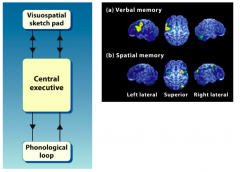
What is Baddeley and Hitch's model of working memory?
|
the central executive which acts as supervisory system and controls the flow of information from and to its slave systems: the phonological loop (verbal/ auditory) and the visuo-spatial (what we see) sketchpad. The slave systems are short-term storage systems dedicated to a content domain
|
|

What is the current view of working memory?
|
material-specific buffers
rehearsal processes executive processes articulation with long-term memory |
|
|
What are 5 characteristics of explicit (conscious) long term memory?
|
Intentional recollection of previous experience
declarative fact memory knowing what |
|
|
What are 5 characteristics of implicit (unconscious) long term memory?
|
non-intentional form of memory
non declarative skill habit knowing how |
|
|
Which type of long term memory is usually spared in amnesia?
|
implicit memory (procedural memory)
|
|
|
How does the fragment completion task relate to implicit memory?
|
If participants are primed by previously seeing the word list, then they will have implicit memory of the words and get more fragment completions correct compared to those who had never seen the original word before
|
|
|
Gollin figure test
|
assess someone's implicit and explicit memory. Subjects are shown a series of drawings in a sequence, from least to most clear, and asked to identify the image. The object cannot possibly be identified in the first sketch, and most people must see several of the panels before they can identify it. On a retention test some time later, however, subjects identify the image sooner than they did on the first test, indicating some form of memory for the image
|
|
|
What is episodic memory?
|
a form of declarative memory that requires detailed recall of specific events or details
|
|
|
What is the difference between semantic and episodic memory?
|
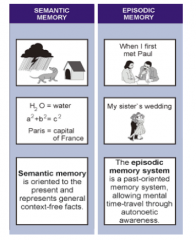
semantic is knowing while episodic is remembering
|
|
|
Where was K.C. damage?
|
Bilateral hippocampus and frontal lobe damage
|
|
|
What kind of amnesia did KC suffer from?
|
severe retrograde and anterograde amnesia
no episodic memory but intact semantic memory |
|
|
Pyramids and Palm Trees Test
|
Tests ability to access semantic knowledge from words or pictures
|
|
|
What did Patient A.M. suffer from?
|
semantic dementia
|
|
|
What parts of the brain are affected with hippocampal damage?
|
impaired episodic memory and intact semantic memory
|
|
|
What parts of the brain are affected with lateral temporal damage?
|
impaired semantic memory and intact episodic memory
|
|
|
Describe an fMRI of the hippocampus
|
material dependent activity at encoding
verbal - left nonverbal- right |
|
|
If there is a hippocampal lesion on the left side?
|
Material specific memory disorder with verbal impairment
|
|
|
What lobe is the hippocampus located in?
|
The medial temporal lobe
|
|
|
Which memory processes is the medial temporal lobe, specifically the hippocampus involved in?
|
explicit memory processes
|
|
|
Are memories stored in the hippocampus?
|
No because if memories are stored in the hippocampus then remote and recent memories would be equally lost. According to Ribot's law, remote memories seem to be spared
|
|
|
What is the best description for the hippocampus in relation to memories?
|
The hippocampus is an indexer of memory, not a storage site
|
|
|
what is memory consolidation?
|
a category of processes that stabilize a memory trace after the initial acquisition. Consolidation is distinguished into two specific processes, synaptic consolidation, which occurs within the first few hours after learning, and systems consolidation, where hippocampus-dependent memories become independent of the hippocampus over a period of weeks to years
|
|
|
Why are older memories (remote memories) usually spared in retrograde amnesia?
|
The hippocampus consolidates new memories, however it is a slow process
|
|
|
What is the Multiple Trace Theory (MTT)
|
It posits that each time some information is presented to a person, it is neurally encoded in a unique memory trace composed of a combination of its attributes
|
|
|
How does multiple trace theory relate to the hippocampus?
|
The hippocampus is necessary for retrieval of all truly episodic memories and acts as a pointer to the neocortex where details are stored
|
|
|
How does Multiple trace theory explain the temporal gradient?
|
Over time as episodic memory is remembered, it becomes recoded throughout the hippocampus which is why more extensive hippocampal damage is necessary to expunge more remote episodic memories. The more episodic details remembered, the more hippocampal acitivation
|
|
|
Episodic memory is dependent on what?
|
context dependent: associations between faces, names, places, events times etc.
|
|
|
How does the hippocampus relate to context?
|
It has been suggested that the hippocampus if important for contextual learning (relations between items)
|
|
|
What are associative retrieval?
|
conscious recollection that are cue-driven (MTL)
|
|
|
what are 4 characteristics of strategic retrieval?
|
problem solving approach to memory where:
1) frontal lobes work with memories 2) delivered through the medial temporal lobes and posterior neocortex 3) ventrolateral PFC (retrieval effort) 4) ventromedial PFC (retrieval monitoring) |
|
|
What is confabulation?
|
a memory disturbance, defined as the production of fabricated, distorted or misinterpreted memories about oneself or the world, without the conscious intention to deceive. There is no intent to deceive because the person is unaware the information they are giving is false
|
|
|
Which retrievals are intact and impaired in confabulation?
|
Associative retrieval intact, strategic retrieval impaired
|
|
|
What are the 5 symptoms of Korsakoff's syndrome?
|
1) retrograde amnesia
2) anterograde amnesia 3) lack of insight/ apathy 4) meager content in conversation 5) confabulations (the recitation of imaginary experiences to fill gaps in memory) |
|
|
What is Korsakoff's syndrome?
|
damage to diencephalon causes amnesia which is a result of chronic alcoholism (B1 deficiency)
|
|
|
What is dissociative amnesia?
|
very rare and often triggered by high stress. Short lived loss of personal information often accompanied by wandering. When this period has passed, there is no memory for the fugue interval
|
|
|
What is arousal?
|
A generalized sense of alertness
|
|
|
What are the cognitive components of sustained attention?
|
Duration of focus, vigilance
|
|
|
What are the cognitive components of selective attention?
|
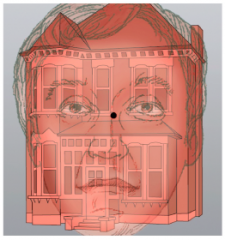
prioritization of information among competing representations
|
|
|
What are the cognitive components of divided attention?
|
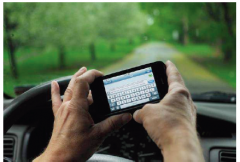
allocation of resources between different tasks
|
|
|
What is the neuroanatomy of attention? (6)
|
1) reticular activating system
2) superior colliculus 3) thalamus 4) parietal lobe 5) frontal lobe 6) cingulate cortex |
|

What is this a picture of and what type of processing is it a major neuroanatomical structure of?
|
The parietal lobe is a major neuroanatomical structure in attentional processing
|
|
|
What is neglect?
|
Neglect is not due to left hemianopia. The patients are not aware they do not see one half of the visual field. They completely ignore left side of space because they are unaware it is there
|
|
|
What is the difference between hemianopia patients and neglect patients?
|
hemianopia patients know they cannot see the left visual field so they will turn their head to the left to see what is in that visual field.
|
|
|
Is neglect homogeneous?
|
no it varies patient to patient
|
|
|
What is object centered neglect?
|
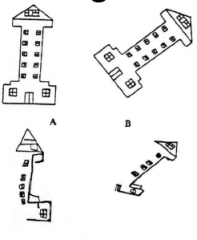
It is when patients neglect the right side of an object
|
|
|
What is unilateral neglect?
|

Body centered neglect and object centered neglect
|
|
|
is there evidence that shows neglected stimuli can still influence future behavior?
|
Yes the burning house picture presented to patients with neglect. They are not consciously aware of the side of the house that is shown to be on fire, however when asked which house they would prefer to live in, (both look the same to them) they choose the house that didn't have the fire on one side
|
|
|
Can you recover from neglect?
|
yes but it is often partial recovery
|
|
|
What does neglect tell us about attention?
|
Perception is not sufficient and one must be aware of the processed information
|
|
|
Why does neglect usually occur in the left visual field?
|
Right hemisphere dominance for attention
|
|
|
What are 3 characteristics of alertness?
|
sustained attention
arousal vigilance |
|
|
What can alertness be compared to?
|
a flashlight shining a beam of light
|
|
|
What is an example of top down modulation based on relevance in regards to alertness?
|
You have an overall goal of learning so you attend to the information being presented in lecture
|
|
|
What are 4 characteristics of (re) orientating?
|
directing and re-directing attention
disengage and shift attention flashlight movement neglect: failure to move attention |
|
|
What is a working model of attention?
|
alertness
(re) orienting executive control |
|
|
What is supervisory control (executive)?
|
mediating and monitoring interaction between top-down and bottom up processing
detecting meaningful information in an environment in a goal directed way |
|
|
where is alertness located?
|
Right lateralized, frontal-parietal-thalamic network
Dorsal attention system |
|
|
Where is (re) orienting take processed?
|
Subcortical and parietal areas
Ventral attention network |
|
|
Where is the executive control of attention located?
|
prefrontal cortex
|
|
|
Which areas of the brain are active for sustained attention?
|
dorsolateral prefrontal cortex (executive) and superior parietal lobe
|
|
|
Which areas of the brain are suppressed for sustained attention?
|
posterior cingulate cortex and medial prefrontal cortex (default network)
|
|
|
What are the three cognitive operations of orienting?
|
disengaging
shifting re-engaging/reading *The in class activity with clapping on 3 |
|
|
What does the superior colliculus do in regards to orienting?
|
Controls ability to visually fixate on or foveate a stimulus; saccadic eye movements
|
|
|
What does the reticular activating system do in regards to orienting?
|
It maintains arousal to support attentional processing
|
|
|
What is ventral attention network for in regards to orientation?
|
it is for shifting attention and orienting you to other stimulus
|
|
|
Which part of the brain plays a more supportive role in response selection and error detection?
|
The anterior cingulate cortex (an executive function of attention)
|
|
|
Describe the frontal lobes
|
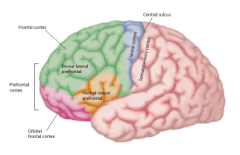
high level, executive control of attention including dividing attention between two tasks
|
|
|
What is selective attention?
|
There is selective enhancement for what you're goal-directed attending to and suppression of what you're not suppose to be focusing on
ie faces >scenes task remember scenes only |
|
|
Is all information treated equally in the brain?
|
No, non behaviorally relevant information is filtered out of awareness. What you choose to focus on changes the activation pattern downstream
|
|
|
How do the dorsal and ventral attention networks interact with the default network?
|
The dorsal attention network and the default network tradeoff. When the default is active, the dorsal is suppressed vice versa.
|
|
|
Can the dorsal and ventral attention networks be active at the same time?
|
Yes they can
|
|
|
What are the 6 regions of the brain involved in dorsal and ventral attention networks?
|

1) inferior frontal gyrus
2) dorsolateral prefrontal cortex 3) frontal eye field 4) inferior parietal lobe 5) superior parietal lobe 6) temporo-parietal junction |
|
|
What are the 3 regions of the brain involved in the default network?
|
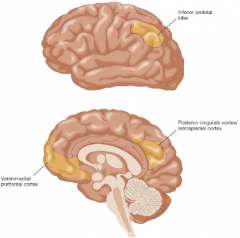
1) inferior parietal lobe
2) posterior cingulate cortex/retrospienal cortex 3) ventromedial prefrontal cortex |
|
|
What do the frontal eye fields (FEF) and intraparietal sulcus (IPS) do in the dorsal attention network?
|
They send top-down biasing signals
|
|
|
What does the right middle frontal gyrus (R MFG) do in the ventral attention network?
|
It is a filtering mechanism for the ventral attention network
|
|
|
Which network coordinates stimulus-response selection?
|
dorsal network
|
|
|
What happens when a salient stimulus occurs during stimulus-driven reorienting?
|
The ventral network sends a reorienting signal to the dorsal network through middle frontal gyrus
|
|
|
Which cortex plays a crucial role in cognitive control and goal-oriented behavior?
|
prefrontal cortex
|
|
|
What is cognitive control?
|
cognitive control are mental abilities that involve planning, controlling and regulating the flow of information processing
|
|
|
what is goal-oriented behavior?
|
interacting with the world in a purposeful manner
|
|
|
What percentage of the cortex does the prefrontal cortex represent?
|
20% and includes everything in front of the central sulcus
|
|
|
Who came up with the ice-pick (frontal or transorbital) lobotomy?
|
Walter Freeman
|
|
|
What was the effectiveness of frontal lobotomies?
|
roughly 1/3 improved, 1/3 remained unchanged and 1/3 got worse
|
|
|
What do patients with damage to the prefrontal cortex show difficulties in?
|
planning
decision making judgement |
|
|
What are executive functions?
|
Integrative cognitive functions that determine goal-directed and purposeful behavior and are superordinate in the orderly execution of daily life functions
|
|
|
What are some analogies for executive functions?
|
Orchestra conductor and corporate CEO
|
|
|
What are 5 key elements of executive control?
|
1) initiation, cessation and control of action
2) abstract thinking 3) estimating and predicting 4) cognitive flexibility 5) goal-directed behavior |
|
|
What are 4 common themes of executive control?
|
1) planning
2) decision making 3) judgement 4) self-perception |
|
|
Describe planning (3)
|
goal setting
future thinking strategy formulation |
|
|
Describe descision making (4)
|
self appraisal
option formulation response selection action initiation |
|
|
Describe judgment
|
weighing options: 'on-line' consideration of response alternatives and their merits
|
|
|
describe self-perception (3)
|
self-monitoring
modulation (utilizing feedback to alter course behavior) introspection |
|
|
Name 6 non executive functions
|
speech, perception, movement, associative learning, habits, reading
|
|
|
Name 6 executive functions
|
cognitive control
planning working memory selective attention response inhibition (overriding habits) problem solving |
|
|
What are 5 signs of executive function deficits?
|
Intelligence preserved
poor planning/disorganized behavior inappropriate emotional response lack of drive unawareness/unconcern |
|
|
What portion of the brain was damaged in Phineas Gages?
|
Prefrontal cortex (bilateral anterior oribtofrontal cortex and a portion of the anterior cingulate gyrus)
|
|
|
What happened to Phineas Gage as a result of his injury?
|
His personality shifted completely: fitful, irreverent, indulging at times in the grossest profanity, impatient of restrain or advice
|
|
|
When a patient has orbitofrontal/ventromedial damage do they know that what they are doing is wrong?
|
There is a separation of knowledge from action. They realize that it is something that shouldn't be done and say that other shouldn't do it but they cannot refrain themselves from acting in a socially unacceptable manner
|
|
|
What is environmental dependency?
|
It is when patients with orbitofrontal/ventomedial damage exhibit utilization behavior
|
|
|
What is utilization behavior?
|
It is when the presentation of objects within reach or visual field compels patients to use them
ie food in the room, they will eat it even if its on someone else's plate |
|
|
What type of brain damage did 'Dr. Zorro' have?
|
orbitofrontal/ventromedial damage; he had the impulse to act and didn't consider that it was totally unnacceptable
|
|
|
What symptoms do patients with orbitofrontal/ventromedial damage exhibit? (5)
|
increased risk-taking
disturbed social component/ poor insight self-regulatory disorder pseudopsychopathic disinhibtion |
|
|
What symptoms do patients with anterior cingulate/supplementary motor area damage exhibit? (4)
|
Poor self-initiation
SMA damage affects planning and initiation of movements based on past experience monitoring deficits apathy |
|
|
What symptoms do patients with dorsolateral prefrontal damage exhibit? (2)
|
cognitive rigidity
typical dysexecutive syndrome |
|
|
what are the 4 characteristics of typical dysexecutive syndrome?
|
poor abstract reasoning (concrete thinking)
task impersistence poor planning goal neglect |
|
|
What 6 areas are included in the prefrontal cortex?
|
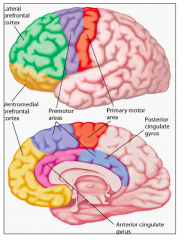
lateral prefrontal cortex
ventromedial prefrontal cortex premotor areas primary motor area posterior cingulate gyrus anterior cingulate gyrus |
|
|
What is the process of cognitive control of goal-directed behavior?
|
identify goals and subgoals
link subgoals into a plan of action select relevant and filter out irrelevant information switch from one task to another when subgoal is complete |
|
|
What does a deficits in working memory (frontal lobe executive function) look like?
|
difficulty retaining information (concentrating) or managing multiple tasks at once
|
|
|
What are some ways to assess deficits in working memory (frontal lobe executive function)?
|
digit span (concentration)
alphaspan (multiple demands in memory) |
|
|
What does the the executive function assessment using digit span challenge (forward and backwards)?
|
Forward: storage/rehearsal in working memory
Backward: storage/rehearsal + maniplulation |
|
|
What does a deficits in control of action/flexibility of frontal lobe executive function look like?
|
not having an ability to flexibly alter behavior based on changing contingencies (shifting sets)
|
|
|
What is one way to assess deficits in control of action/flexibility in frontal lobe executive function?
|
Wisconsin card sorting task
|
|
|
What is the Wisconsin card sorting task?
|
few explicit rules/instructions
participants must sort cards according to 3 categories (not known initially) sorting criteria changes without warning |
|
|
What are the 3 rules of sorting in the wisconsin card sorting task?
|
shape
color numerosity |
|
|
How does the Wisconsin card sorting task work?
|
the experimenter indicates whether the response is correct or incorrect, allowing the subject to learn the sorting rule by trial and error. The sorting rule changes whenever the subject makes 10 consecutive correct responses
|
|
|
What do deficits in inhibition of pre-potent responses of frontal lobe executive function look like?
|
inability to withhold habitual responses or responses to highly salient environmental stimuli
switching |
|
|
What are ways to assess deficits in inhibition of pre-potent responses in frontal lobe executive function?
|
Trail-making tests
stroop color-word interference task |
|
|
What is the trail making test (A & B)?
|
used to ***** speed of attention, visual search and motor function, mental flexibility and shifting
|
|
|
What does TMT A look like?
|

|
|
|
What does TMT B look like?
|
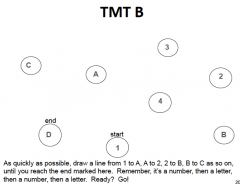
|
|
|
What does the Stroop test of interference look like?
|
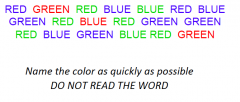
|
|
|
What do deficits in loss of goal-directed behavior of frontal lobe executive function look like?
|
the inability to plan
|
|
|
What are ways to assess deficits in loss of goal-directed behavior in frontal lobe executive function?
|
Tower of London
Multiple Errands/six elements test |
|
|
How do patients with prefrontal cortex damage do in the tower of london task?
|
They don't plan very well so they are inefficient and ineffective at this task (too many moves, unnecessary aimless moves)
|
|
|
What do patients do during the multiple errands task (MET)?
|
patients are given a list of errands to run in a real-world environment and then asked to go do it (not a memory task but patients have to figure out how to accomplish the tasks most efficiently 15mins)
|
|
|
What are some functions the frotoparietal cortex carry out?
|
subgoaling
relational integration episodic goal monitoring shifting from internal to external attention |
|
|
What are some functions the mid-dorsolateral PFC carry out?
|
task switching
super-sequence selection sequence categorization win-stay, lose-shift strategy maintaining cross-temporal contingencies match non-match rule |
|
|
What are some functions the PMd carry out?
|
response selection
S-R rule selection match-non-match rule |
|
|
What are some functions the pre-PMd/caudal PFC carry out?
|
response sequence selection
sequence categorization S-R rule leanring win-stay, lose-shift strategy match-non-match rule |
|
|
What is flexibility in cognitive domain?
|
switch from one task OR rule to another
|
|
|
What id inhibition in the cognitive domain?
|
Inhibit prepotent response in order to make correct, but less common, response
|
|
|
What is working memory in the cognitive domain?
|
maintains information/context/temporal or spatial relationships online and manipulate or use that information to guide response selection
|
|
|
What is initiation in cognitive domain?
|
initiate sequence of complex behaviors
|
|
|
what is planning in cognitive domain?
|
identify and organize steps and elements needed to carry out an intention or achieve a goal
|

